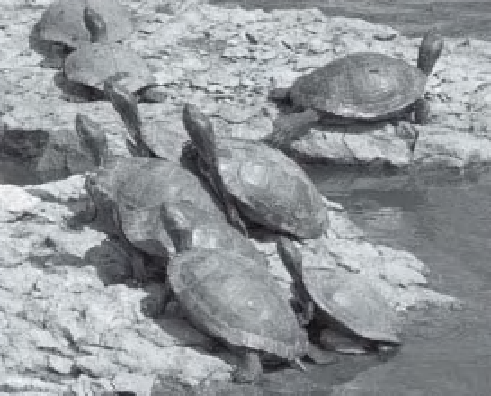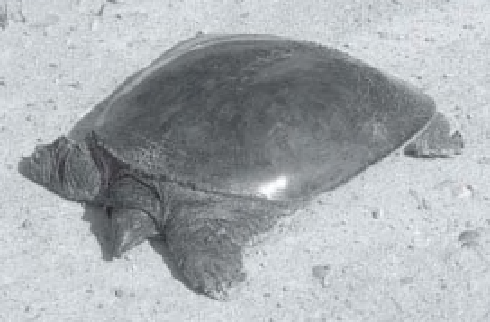Geoscience Reference
In-Depth Information
Around the world, amphibians face a crisis
of extinctions, which is taking place even in
well-protected nature refuges. Of nearly 6000
amphibian species, more than 40% have experi-
enced recent declines, and some 30% are faced
with possible extinction
-
a situation that is
much worse than for birds and mammals (Elliot,
Gerhardt and Davidson 2009). The reasons for
this precipitous decline are many and varied;
i ve main causes are cited: introduced (non-
native) species, increased ultraviolet radiation,
diseases and parasites, climatic change, and
toxic pollution.
Non-native species and increased ultraviolet
radiation appear to be marginal or insignii cant
factors in most cases. Disease caused by a
chytrid fungus (
Batrachochytrium dendroba-
tidis
) is the leading explanation in the Americas,
Africa, Europe, Australia and New Zealand
(Elliot, Gerhardt and Davidson 2009). It is pos-
sible that global warming contributes to chytrid
fungus outbreaks, and toxic pollution may
weaken amphibian immune systems. The gro-
tesquely deformed frogs discovered in Minne-
sota in 1995 and elsewhere since then were
results of a parasitic trematode l uke, which
thrives on agricultural fertilizer runoff. Still
many uncertainties remain, and investigations
continue into the causes and solutions for
amphibian declines.
A
B
Figure 7-14.
Aquatic turtles. A. Group of red-eared
sliders (
Trachemys scripta
) sunning on a rock in a
pond display their distinctive hard carapaces and
scutes. B. The spiny softshell turtle (
Apalone spiniferus
)
has a smooth carapace that lacks scutes. The elongated
snout is used as a snorkel while under water, and the
olive-brown shell is well camoul aged on sandy or
muddy substrates. Quivira National Wildlife Refuge,
Kansas, United States. Photos by J.S. Aber.
7.3.2 Reptiles
Reptiles, including alligators, turtles, lizards and
snakes, are generally less dependent on aquatic
or wetland habitats for their life cycles than are
amphibians. They do not need to return to water
or moist places to lay their eggs. Most reproduce
via eggs that are laid on land, although some
snakes bear living young without an external
egg phase. The turtle shell and scales of other
reptiles protect them from rapid dehydration, so
they may venture far from water bodies. None-
theless, many reptiles are adapted for life in or
near water either through morphology or behav-
ior and, so, spend most of their time in wetlands
close to water bodies.
All turtles (order Testudines) have shells.
Some shells are hard structures covered with
large scales (scutes), and others have soft, leath-
ery shells that lack scutes (Fig. 7-14). The iden-
tii cation of many turtles is based on the size,
shape, and color of scutes (Fig. 7-15). Many
turtles are primarily aquatic; for example, of 17
turtle species found in Oklahoma, 15 inhabit
rivers, lakes, marshes and other aquatic environ-
ments (Sievert and Sievert 2006). Turtles are
for the most part omnivores that eat a variety
of small animals, carrion, and plant materials.
Among some species, however, the young are
carnivores and adults become primarily herbiv-
ores, such as the painted turtle (
Chrysemys






